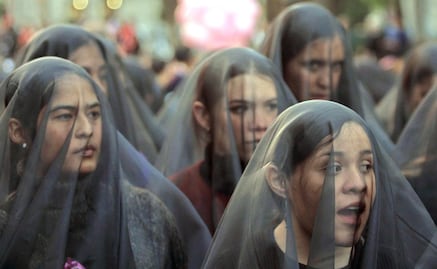Más Información

Dan prisión preventiva a César Duarte, exgobernador de Chihuahua; se queda en el Altiplano por lavado de dinero

SSC refuerza operativo vial por peregrinos; emiten recomendaciones para conductores en el cerro del Tepeyac
In Mexico , the reports concerning sexual offenses have increased in recent years. According to the Executive Secretary of Mexico’s National System for Public Security (SESNSP) , during the first semester of 2019, 25,277 investigation files related to these offenses have been opened, that is, 17% more compared to the same period in 2018 in the country.
In the first half of the current year, the most reported offenses were sexual abuse , with 11,691 cases; rape , with 6,594 cases; other unspecified offenses, with 2,382 cases; sexual harassment , with 1,978 ; equivalent of rape , with 1,870 cases; and incest with 17 .
Since 2015 , sexual abuse and rape have remained as the most reported sexual offenses, nonetheless, specialists said that official figures can fall short of the actual dimension of the problem, since crimes like harassment are hardly presented before authorities.
Mexico City
and the State of Mexico are emblematic examples of the increase of investigation files: during the first semester of 2018 , both entities registered 1,971 investigations for sexual offenses, while during the start of 2019, 3,233 files were opened in Mexico City and 2,909 in the State of Mexico.
Other states that have accumulated more investigations this year are Jalisco , with 1,788 cases; Chihuahua , with 1,488 ; Nuevo León , with 1,434 ; Baja California , with 1,310 ; and Puebla , with 1,094 .
The states with fewer files are Tlaxcala , with 21 ; Nayarit, with 126 ; Yucatán, with 146 ; Campeche , with 188 ; Colima , with 210 ; Baja California , with 310 ; and Sinaloa , with 312 .
Information from the SESNSP shows that the increase of investigation files for sexual offenses is not recent; since 2015 , this trend has been observed if compared to the first semesters of each year.
During the first half of 2015 , 15,697 investigations were opened; in 2016 , there were 17,576 ; in 2017 , 18,598 , while in 2018 , there were 21,078 .
Civil society organizations
have also set to investigate this issue from different perspective and match in the factors that promote these offenses: gender roles in which women are seen as sexual objects , the lack of reports , impunity in the resolution of cases, as well as the lack of awareness of the people and the public officers who perform the investigations.
Gender and children
Experts interviewed b y EL UNIVERSA L asserted that women, girls, boys, and the LGBTTTIQA community are the most vulnerable sections of society when it comes to sexual attacks.
Ana María Suárez
, CEO of Public Policies, Training, and Research of the Executive Commission of Victim Assistance (CEAV) , said that sexual crimes have a high impact because of the physical and psychological consequences left on those affected, their families and even the communities where they live.
She added that, according to data obtained by the CEAV through the states, 9 out of 10 victims of sexual violence are women , and 40% are under the age of 15 .
Likewise, 9 out of 10 aggressions were made by men , and 70% of the cases happened in the house of the victim.
“After girls suffer the offense, since they are minors , they don’t report because they don’t have the means nor the support from their family or institutions to do so. When they go to the authorities to open an investigation file, only 10 aggressors per 1000 reports are charged,” expressed Juárez.
She calculated that 600,000 sexual offenses are committed every year, hence, she considered essential for states to strengthen their criminal codes and to homologate them so that the access to justice be simple for victims.
Alicia Elena Pérez Duarte y Noroña
, from the Institute for Judicial Research (IIJ) of the National Autonomous University of Mexico (UNAM) , asserted that although women are prone to suffer sexual offenses, the LGBTTTIQA community and male minors can also be the target of attacks.
“The rape of homosexuals , transvestites , transgender , and t ransexual men exist mainly in prisons. These crimes lead to hate crimes ,” she said.
She mentioned that although the government has implemented public policies to eradicate sexual violence, it has done nothing to prevent these offenses from working with men .
She urged for the issue to be attended as soon as possible, since sexual offenses are related to femicide .
“There’s a very clear guiding thread in these acts of violence against women . The first acts of violence like harassment, for example, can be considered minor offenses , but they can lead to femicide if the aggressor is not stopped in time. Femicide even takes into account the previous sexual aggressions against the victim,” she asserted.
Julia Escalante de Haro
, the regional coordinator of the Latin American and Caribbean Committee for the Defense of Women’s Rights , added that sexual crimes “persist for the social construction that we learn (…) about male supremacy , exacerbated sexuality in men and passive in women, a series of stereotypes around the role women and men ‘have’ in society, and in which women are thought of only as pleasure objects .”
She considered that it is necessary to add to such a problem the impunity in the resolution of cases, which causes aggressors not to fear to commit another crime.
“If there’s impunity for the theft of a cellphone, aggressors feel protected to attack women on the street; they feel protected to abuse their daughters at their house because nothing is going to happen.”
mp
Noticias según tus intereses
[Publicidad]
[Publicidad]















